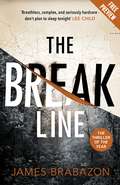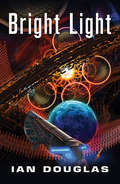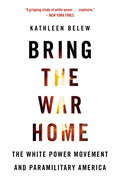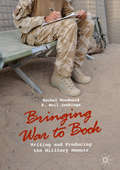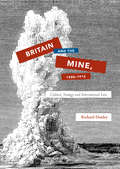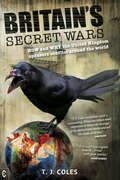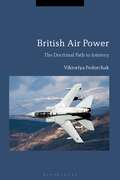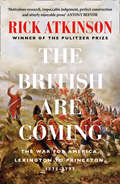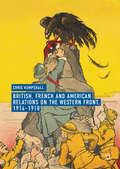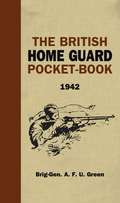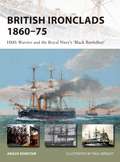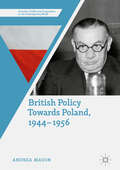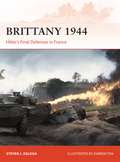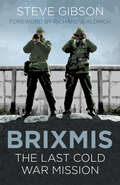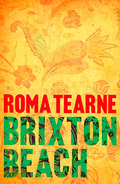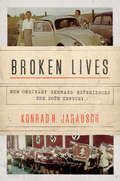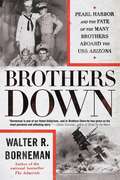- Table View
- List View
The Break Line Free eBook Sampler
by James BrabazonREAD THE OPENING CHAPTERS OF THIS COMPELLING AND SUSPENSE-FILLED DEBUT NOVEL FROM INTERNATIONALLY BESTSELLING AUTHOR JAMES BRABAZON IN THIS FREE PREVIEW. Breathless, complex, and seriously hardcore - don't plan to sleep tonight. LEE CHILDOfficially, Max McLean doesn't exist. The British government denies all knowledge of the work he does on their behalf to keep us safe. But Max and his masters are losing faith in each other. And they give him one last chance to prove he's still their man.Sent to a military research facility to meet a former comrade-in-arms, Max finds the bravest man he ever knew locked up for his own protection. His friend lost his mind during an operation in West Africa. The reason? Absolute mortal terror.Max is determined to find out why. Ahead lies a perilous, breathtaking mission into the unknown that will call into question everything that Max once believed in.Acting alone, without back-up, Max lands in Sierra Leone with his friend's last words ringing in his ears: 'They're coming, Max. They're coming...'The Break Line is a debut dripping with authenticity and menace. Smart, unputdownable and packed with irresistible set pieces and jaw-dropping plot twists, this is a thriller like no other. 'Beautifully written and extensively researched, The Break Line is a riveting page-turner, a gruesome delight, and a study of what lies in the shadowed corners of the human heart' GREGG HURWITZ, author of ORPHAN X'A taught, razor-edged thriller, packed with granular detail and authenticity' JAMES SWALLOW, author of NOMADENJOYED WHAT YOU'VE READ? THE BREAK LINE IS AVAILABLE FOR PRE-ORDER NOW.
Bright Light: Star Carrier: Book Eight (Star Carrier #8)
by Ian DouglasThere’s no more time… There’s always more time…
Bring the War Home: The White Power Movement and Paramilitary America
by Kathleen BelewThe white power movement in America wants a revolution. It has declared all-out war against the federal government and its agents, and has carried out—with military precision—an escalating campaign of terror against the American public. Its soldiers are not lone wolves but are highly organized cadres motivated by a coherent and deeply troubling worldview of white supremacy, anticommunism, and apocalypse. In Bring the War Home, Kathleen Belew gives us the first full history of the movement that consolidated in the 1970s and 1980s around a potent sense of betrayal in the Vietnam War and made tragic headlines in the 1995 bombing of the Oklahoma City federal building. Returning to an America ripped apart by a war that, in their view, they were not allowed to win, a small but driven group of veterans, active-duty personnel, and civilian supporters concluded that waging war on their own country was justified. They unified people from a variety of militant groups, including Klansmen, neo-Nazis, skinheads, radical tax protestors, and white separatists. The white power movement operated with discipline and clarity, undertaking assassinations, mercenary soldiering, armed robbery, counterfeiting, and weapons trafficking. Its command structure gave women a prominent place in brokering intergroup alliances and giving birth to future recruits. Belew’s disturbing history reveals how war cannot be contained in time and space. In its wake, grievances intensify and violence becomes a logical course of action for some. Bring the War Home argues for awareness of the heightened potential for paramilitarism in a present defined by ongoing war.
Bring the War Home: The White Power Movement and Paramilitary America
by Kathleen BelewThe white power movement in America wants a revolution. It has declared all-out war against the federal government and its agents, and has carried out—with military precision—an escalating campaign of terror against the American public. Its soldiers are not lone wolves but are highly organized cadres motivated by a coherent and deeply troubling worldview of white supremacy, anticommunism, and apocalypse. In Bring the War Home, Kathleen Belew gives us the first full history of the movement that consolidated in the 1970s and 1980s around a potent sense of betrayal in the Vietnam War and made tragic headlines in the 1995 bombing of the Oklahoma City federal building. Returning to an America ripped apart by a war that, in their view, they were not allowed to win, a small but driven group of veterans, active-duty personnel, and civilian supporters concluded that waging war on their own country was justified. They unified people from a variety of militant groups, including Klansmen, neo-Nazis, skinheads, radical tax protestors, and white separatists. The white power movement operated with discipline and clarity, undertaking assassinations, mercenary soldiering, armed robbery, counterfeiting, and weapons trafficking. Its command structure gave women a prominent place in brokering intergroup alliances and giving birth to future recruits. Belew’s disturbing history reveals how war cannot be contained in time and space. In its wake, grievances intensify and violence becomes a logical course of action for some. Bring the War Home argues for awareness of the heightened potential for paramilitarism in a present defined by ongoing war.
Bringing War to Book: Writing and Producing the Military Memoir
by Rachel Woodward K. Neil JenkingsThis book explores how military memoirs come to be written and published. Looking at the journeys through which soldiers and other military personnel become writers, the authors draw on over 250 military memoirs published since 1980 about service with the British armed forces, and on interviews with published military memoirists who talk in detail about the writing and production of their books. A range of themes are explored including: the nature of the military memoir; motivations for writing; authors’ reflections on their readerships; inclusions and exclusions within the text; the memories and materials that authors draw on; the collaborations that make the production and publication of military memoirs possible; and the issues around the design of military memoirs' distinctive covers.Written by two leading commentators on the sociology of the military, Bringing War to Book offers a new and original argument about the representations of war and the military experience as a process of social production. The book will be of interest to students and scholars across a range of disciplines including sociology, history, and cultural studies.
Britain and the Mine, 1900–1915: Culture, Strategy and International Law
by Richard DunleyThis book examines Britain’s complex relationship with the mine in the years 1900-1915. The development of mine warfare represented a unique mix of challenges and opportunities for Britain in the years before the First World War. The mine represented the antithesis of British maritime culture in material form, and attempts were made to limit its use under international law. At the same time, mine warfare offered the Royal Navy a solution to its most difficult strategic problem. Richard Dunley explores the contested position occupied by the mine in the attitudes of British policy makers, and in doing so sheds new light on the overlapping worlds of culture, strategy and international law.
Britain and the Mine, 1900–1915: Culture, Strategy and International Law
by Richard DunleyThis book examines Britain’s complex relationship with the mine in the years 1900-1915. The development of mine warfare represented a unique mix of challenges and opportunities for Britain in the years before the First World War. The mine represented the antithesis of British maritime culture in material form, and attempts were made to limit its use under international law. At the same time, mine warfare offered the Royal Navy a solution to its most difficult strategic problem. Richard Dunley explores the contested position occupied by the mine in the attitudes of British policy makers, and in doing so sheds new light on the overlapping worlds of culture, strategy and international law.
Britain's Secret Wars: How and Why the United Kingdom Sponsors Conflict Around the World
by T. J. ColesIn a devastating analysis, T. J. Coles reveals the true extent of Britain’s covert foreign policy that supports war, conflict and oppression around the world. Unbeknownst to the broad population, the Shadow State sponsors a ‘new world order’ that allies Britain with America’s quest for global power – what the Pentagon calls ‘Full Spectrum Dominance’. Coles documents how British operatives have interfered in Syria, Libya, Iraq, Iran and Yemen with the aim of deposing unwanted regimes. In doing so, they have helped create extensive terrorist networks across the Middle East, reviving previously-failing Jihadist groups such as ISIL, which has now transformed into an international terror franchise.In addition to waging clandestine wars in the Middle East, the secret services have used the military to run drugs by proxy in Colombia, train death squads in Bangladesh and support instability in Ukraine, where NATO’s strategic encroachment on Russia is drawing the world closer to terminal nuclear confrontation. Coles unearths Britain’s involvement in the recent ethnic cleansing of Tamil civilians by the Sri Lankan government, the invasion of Somalia by Somali and Ethiopian warlords, and Indonesia’s atrocities in Papua. He also exposes the extensive use of drones for murder and intimidation across the Middle East and elsewhere.Britain’s Secret Wars is essential reading for anyone who wants to dig beneath the surface of current events.
British Air Power: The Doctrinal Path to Jointery
by Viktoriya FedorchakBritish Air Power demonstrates how the Royal Air Force sought to adapt in regard to the roles it could play and the conflicts in which it could be used, as well as the evolution of air power doctrine at a time of rapid changes in national politics and in the international arena. The development of new concepts and theories, the evaluation of operational experience, the political environment and budgetary cuts, and the role of academics and personalities in development of doctrine are thus all explored to show changes in strategic thinking regarding air power.Fedorchak further examines the influence of jointery – the process of co-operation between the army, navy and air force – on thinking, conceptualising, teaching and using air power in recent operations in Afghanistan, Iraq, Libya and Syria. A contemporary complement to more historical studies, British Air Power provides a very detailed look at the development of air-land doctrine in the RAF since the turn of the century.
The British Are Coming: The War For America, Lexington To Princeton, 1775-1777 (The\revolution Trilogy Ser. #1)
by Rick Atkinson‘To say that Atkinson can tell a story is like saying Sinatra can sing … A powerful new voice has been added to the dialogue about [America’s] origins as a people and a nation. It is difficult to imagine any reader putting this beguiling book down without a smile and a tear.’ New York Times
British Children's Literature and the First World War: Representations since 1914
by David BudgenPerceptions of the Great War have changed significantly since its outbreak and children's authors have continually attempted to engage with those changes, explaining and interpreting the events of 1914-18 for young readers. British Children's Literature and the First World War examines the role novels, textbooks and story papers have played in shaping and reflecting understandings of the conflict throughout the 20th century. David Budgen focuses on representations of the conflict since its onset in 1914, ending with the centenary commemorations of 2014. From the works of Percy F. Westerman and Angela Brazil, to more recent tales by Michael Morpurgo and Pat Mills, Budgen traces developments of understanding and raises important questions about the presentation of history to the young. He considers such issues as the motivations of children's authors, and whether modern children's books about the past are necessarily more accurate than those written by their forebears. Why, for example, do modern writers tend to ignore the global aspects of the First World War? Did detailed narratives of battles written during the war really convey the truth of the conflict? Most importantly, he considers whether works aimed at children can ever achieve anything more than a partial and skewed response to such complex and tumultuous events.
British Destroyer vs German Destroyer: Narvik 1940 (Duel)
by David Greentree Alan Gilliland Mr Paul Wright Mr David CampbellThe opening months of World War II saw Britain's Royal Navy facing a resurgent German navy, the Kriegsmarine. Following the German invasion of Denmark and Norway in early April 1940, British and German destroyers would clash in a series of battles for control of the Norwegian coast. The operational environment was especially challenging, with destroyer crews having to contend with variable weather, narrow coastal tracts and possibility of fog and ship breakdowns.In two engagements at Narvik, the Royal Navy entered the harbour and attacked the loitering German destroyers who had dropped off mountain troops to support the German invasion. The raids were devastating, halving at a stroke the number at Hitler's disposal. Employing specially commissioned artwork and drawing upon a range of sources, this absorbing study traces the evolving technology and tactics employed by the British and German destroyer forces, and assesses the impact of the Narvik clashes on both sides' subsequent development and deployment of destroyers in a range of roles across the world's oceans.
British Flag Officers in the French Wars, 1793-1815: Admirals' Lives
by John MorrowDuring the French wars (1793-1801, 1803-1815) the system of promotion to flag rank in the Royal Navy produced a cadre of admirals numbering more than two hundred at its peak. These officers competed vigorously for a limited number of appointments at sea and for the high honours and significant financial rewards open to successful naval commanders. When on active service admirals faced formidable challenges arising from the Navy's critical role in a global conflict, from the extraordinary scope of their responsibilities, and from intense political, public and professional expectations. While a great deal has been written about admirals' roles in naval operations, other aspects of their professional lives have not been explored systematically.British Flag Officers in the French Wars, 1793-1815 considers the professional lives of well-known and more obscure admirals, vice-admirals and rear-admirals. It examines the demands of naval command, flag officers' understanding of their authority and their approach to exercising it, their ambitions and failures, their professional interactions, and their lives afloat and onshore. In exploring these themes, it draws on a wide range of correspondence and other primary source material. By taking a broad thematic approach, this book provides a multi-faceted account of admirals' professional lives that extends beyond the insights that are found in biographical studies of individual flag officers. As such, it will be of great interest to students and scholars of British naval history.
British Flag Officers in the French Wars, 1793-1815: Admirals' Lives
by John MorrowDuring the French wars (1793-1801, 1803-1815) the system of promotion to flag rank in the Royal Navy produced a cadre of admirals numbering more than two hundred at its peak. These officers competed vigorously for a limited number of appointments at sea and for the high honours and significant financial rewards open to successful naval commanders. When on active service admirals faced formidable challenges arising from the Navy's critical role in a global conflict, from the extraordinary scope of their responsibilities, and from intense political, public and professional expectations. While a great deal has been written about admirals' roles in naval operations, other aspects of their professional lives have not been explored systematically.British Flag Officers in the French Wars, 1793-1815 considers the professional lives of well-known and more obscure admirals, vice-admirals and rear-admirals. It examines the demands of naval command, flag officers' understanding of their authority and their approach to exercising it, their ambitions and failures, their professional interactions, and their lives afloat and onshore. In exploring these themes, it draws on a wide range of correspondence and other primary source material. By taking a broad thematic approach, this book provides a multi-faceted account of admirals' professional lives that extends beyond the insights that are found in biographical studies of individual flag officers. As such, it will be of great interest to students and scholars of British naval history.
British, French and American Relations on the Western Front, 1914–1918
by Chris KempshallThis book provides a thorough examination of the relations between the men in the British, French and American armies on the Western Front of the First World War. The Allied victory in 1918 was built on the backs of British, French, and American soldiers who joined together to fight for a common cause. Using the diaries, records, and letters of these men, Chris Kempshall shows how these soldiers interacted with each other during four years of war. The British army that arrived in France in 1914 became isolated from their French allies and unable to coordinate with them. By 1916, Britain’s professional soldiers were replaced by civilians who learned to love their French ally, who reached out to them in friendship. At the end of the war the introduction of American soldiers caused hope and conflict before perceived British failures brought the alliance to the brink of collapse. Final cooperation between these three nations saw them victorious.
British, French and American Relations on the Western Front, 1914–1918
by Chris KempshallThis book provides a thorough examination of the relations between the men in the British, French and American armies on the Western Front of the First World War. The Allied victory in 1918 was built on the backs of British, French, and American soldiers who joined together to fight for a common cause. Using the diaries, records, and letters of these men, Chris Kempshall shows how these soldiers interacted with each other during four years of war. The British army that arrived in France in 1914 became isolated from their French allies and unable to coordinate with them. By 1916, Britain’s professional soldiers were replaced by civilians who learned to love their French ally, who reached out to them in friendship. At the end of the war the introduction of American soldiers caused hope and conflict before perceived British failures brought the alliance to the brink of collapse. Final cooperation between these three nations saw them victorious.
The British Home Guard Pocketbook
by A.F.U. GreenThe Home Guards are an attacking force lying in wait for, and ready to destroy, and enemy who dares to set foot on out shores.' The Home Guard has been immortalised in British culture in the TV series Dad's Army. Formed by men not eligible for active service – too old, too young, in reserved occupations vital to the war effort – who were expected to resist a German invasion with any resources they had to hand, the Home Guard is the embodiment of plucky British resolve against the odds. The Home Guard Pocket-Book evokes this spirit. Written by Brig-Gen Green, commanding 4th battalion, Sussex Home Guard and Training Adviser for the Sussex Zone, this book is based on his experience and, in his own words, 'is the result of my ransacking the dusty pigeon-holes of memory and the condensation of many books, official instructions and writings'. Its tone is informal and colloquial, such as: 'March discipline. Troops will always march off the parade ground at the Slope. As soon as this has been done the order "March at Ease" should be given. When marching at ease the rifle may be carried in any way a soldier fancies.' Nevertheless, the book is full of sound advice on training, organisation and discipline, fire arms, reconnaissance and field engineering, the responsibilities of the Group Pigeon Officer, the proper position to adopt for surviving a dive bomb attack, and how to set a trap for an unwary advancing German cyclist!
British Ironclads 1860–75: HMS Warrior and the Royal Navy's 'Black Battlefleet' (New Vanguard #262)
by Angus Konstam Mr Paul WrightIn November 1859, the French warship La Gloire was launched. She was the world's first seagoing ironclad - a warship built from wood, but whose hull was clad in a protective layer of iron plate. Britain, not to be outdone, launched her own ironclad the following year - HMS Warrior - which, when she entered service, became the most powerful warship in the world. Just like the Dreadnought half a century later, this ship changed the nature of naval warfare forever, and sparked a frantic arms race. The elegant but powerful Warrior embodied the technological advances of the early Victorian era, and the spirit of this new age of steam, iron and firepower. Fully illustrated with detailed cutaway artwork, this book covers the British ironclad from its inception and emergence in 1860, to 1875, a watershed year, which saw the building of a new generation of recognisably modern turreted battleships.
British Policy Towards Poland, 1944–1956 (Security, Conflict and Cooperation in the Contemporary World)
by Andrea MasonThis book examines the outcome of the British commitment to reconstitute a sovereign Polish state and establish a democratic Polish government after the Second World War. It analyses the wartime origins of Churchill’s commitment to Poland, and assesses the reasons for the collapse of British efforts to support the leader of the Polish opposition, Stanisław Mikołajczyk, in countering the attempt by the Polish communist party to establish one-party rule after the war. This examination of Anglo-Polish relations is set within the broader context of emerging early Cold War tensions. It addresses the shift in British foreign policy after 1945 towards the US, the Soviet Union and Europe, as British leaders and policymakers adjusted both to the new post-war international circumstances, and to the domestic constraints which increasingly limited British policy options. This work analyses the reasons for Ernest Bevin’s decision to disengage from Poland, helping to advance the debate on the larger question of Bevin’s vision of Britain’s place within the newly reconfigured international system. The final chapter surveys British policy towards Poland from the period of Sovietisation in the late 1940s up to the October 1956 revolution, arguing that Poland’s process of liberalisation in the mid-1950s served as the catalyst for limited British reengagement in Eastern Europe.
Brittany 1944: Hitler’s Final Defenses in France (Campaign #320)
by Steven J. Zaloga Darren TanOne of the prime objectives for the Allies following the D-Day landings was the capture of sufficient ports to supply their armies. The original Overlord plans assumed that ports along the Breton coast would be essential to expansion of the Normandy beach-head. This included the major ports at Brest and on Quiberon Bay.The newly arrived Third US Army (TUSA) under Lt. Gen. George S. Patton was delegated to take on the Brittany mission. In one of the most rapid mechanized advances of the war, TUSA had the ports of Avranches and Quiberon encircled by the second week of August 1944.But changing priorities meant that most of TUSA was redeployed, meaning only a single corps was left to take the Breton port cities. The fight would drag into 1945, long after German field armies had been driven from France. Using full colour maps and artwork as well as contemporary accounts and photographs, Brittany 1944 is the fascinating story of the siege of Germany's last bastions on the French Atlantic coast.
BRIXMIS: The Last Cold War Mission
by Steve GibsonBRIXMIS (British Commander-in-Chief’s Mission to the Group Soviet Forces of Occupation in Germany) is one of the most covert elite units of the British Army. They were dropped in behind ‘enemy lines’ ten months after the Second World War had ended and continued with their intelligence-gathering missions until the fall of the Berlin Wall in November 1989. During this period Berlin was a hotbed of spying between East and West. BRIXMIS was established as a trusted channel of communication between the Red Army and the British Army on the Rhine. However, they acted in the shadows to steal advanced Soviet equipment and penetrate top-secret training areas. Here Steve Gibson offers a new understanding of the complex British role in the Cold War.
Brixton Beach (Romans, Nouvelles, Recits (domaine Etranger) Ser. #Vol. 6150031)
by Roma TearneOpening dramatically with the horrors of the 2005 London bombings, this is the profoundly moving story of a country on the brink of civil war and a child's struggle to come to terms with loss.
'Broadsword Calling Danny Boy': On Where Eagles Dare
by Geoff DyerFrom the acclaimed writer and critic Geoff Dyer, an extremely funny scene-by-scene analysis of Where Eagles Dare - published as the film reaches its 50th anniversaryA thrilling Alpine adventure starring a magnificent, bleary-eyed Richard Burton and a coolly anachronistic Clint Eastwood, Where Eagles Dare is the apex of 1960s war movies, by turns enjoyable and preposterous. 'Broadsword Calling Danny Boy' is Geoff Dyer's tribute to the film he has loved since childhood: an analysis taking us from its snowy, Teutonic opening credits to its vertigo-inducing climax. For those who have not even seen Where Eagles Dare, this book is a comic tour-de-force of criticism. But for the film's legions of fans, whose hearts will always belong to Ron Goodwin's theme tune, it will be the fulfilment of a dream.'Geoff Dyer's funniest book yet. Who else would work in Martha Gellhorn on the first page of a book on the film Where Eagles Dare?' Michael Ondaatje'One of our greatest living critics, not of the arts but of life itself, and one of our most original writers' Kathryn Schulz, New York Magazine
Broken Lives: How Ordinary Germans Experienced the 20th Century
by Konrad JarauschThe gripping stories of ordinary Germans who lived through World War II, the Holocaust, and Cold War partition—but also recovery, reunification, and rehabilitationBroken Lives is a gripping account of the twentieth century as seen through the eyes of ordinary Germans who came of age under Hitler and whose lives were scarred and sometimes destroyed by what they saw and did.Drawing on six dozen memoirs by the generation of Germans born in the 1920s, Konrad Jarausch chronicles the unforgettable stories of people who not only lived through the Third Reich, World War II, the Holocaust, and Cold War partition, but also participated in Germany's astonishing postwar recovery, reunification, and rehabilitation. Written decades after the events, these testimonies, many of them unpublished, look back on the mistakes of young people caught up in the Nazi movement. In many, early enthusiasm turns to deep disillusionment as the price of complicity with a brutal dictatorship--fighting at the front, aerial bombardment at home, murder in the concentration camps—becomes clear.Bringing together the voices of men and women, perpetrators and victims, Broken Lives reveals the intimate human details of historical events and offers new insights about persistent questions. Why did so many Germans support Hitler through years of wartime sacrifice and Nazi inhumanity? How did they finally distance themselves from this racist dictatorship and come to embrace human rights? Jarausch argues that this generation's focus on its own suffering, often maligned by historians, ultimately led to a more critical understanding of national identity—one that helped transform Germany from a military aggressor into a pillar of European democracy.The result is a powerful account of the everyday experiences and troubling memories of average Germans who journeyed into, through, and out of the abyss of a dark century.
Brothers Down: Pearl Harbor and the Fate of the Many Brothers Aboard the USS Arizona
by Walter R. BornemanA deeply personal and never-before-told account of one of America's darkest days, from the bestselling author of The Admirals and MacArthur at War.The surprise attack at Pearl Harbor on December 7, 1941 remains one of the most traumatic events in American history. America's battleship fleet was crippled, thousands of lives were lost, and the United States was propelled into a world war. Few realize that aboard the iconic, ill-fated USS Arizona were an incredible seventy-nine blood relatives. Tragically, in an era when family members serving together was an accepted, even encouraged, practice, sixty-three of the Arizona's 1,177 dead turned out to be brothers.In Brothers Down, acclaimed historian Walter R. Borneman returns to that critical week of December, masterfully guiding us on an unforgettable journey of sacrifice and heroism, all told through the lives of these brothers and their fateful experience on the Arizona. Weaving in the heartbreaking stories of the parents, wives, and sweethearts who wrote to and worried about these men, Borneman draws from a treasure trove of unpublished source material to bring to vivid life the minor decisions that became a matter of life or death when the bombs began to fall. More than just an account of familial bonds and national heartbreak, what emerges promises to define a turning point in American military history.
